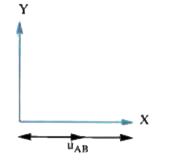A particle A is projected with an initial velocity of 60m/s at an angle 30∘ to the horizontal. At the same time a second particle B is projected in opposite direction with initial speed of 50m/s from a point at a distance of 100 m from A. If the particles collide in air, find (a)the angle of projection α of particle B, (b) time when the collision takes place and (c) the distance of P from A, where collision occurs. (g=10m/s2)

(a) Taking x andy directins as shown in figure
Here , →aA=−gˆj
→aB=gˆj
uAx=60cos30∘=30√3ms:uAy=60sin30∘=30m/s
uBx=−50cosαanduBy=50sinα

Relative acceleration between the two is zero as −→aA=−→aB. Hence, the relative motion between the two is uniform. Condition of collision is that us should be along AB. this is possible only when uAy=uBy i.e., component of relative velocity along y-axis should be zero.
(or) 30=30sinα ∴α=sin−1(3/5)
(b) Now ∣∣−−→uAB∣∣=uax−ubx
=(30√3+50cosα)m/s=(30√3+50×45)m/s=(30√3+40)m/s
Therefore , time of collision is t=AB∣∣−−→uAB∣∣=10030√3+40=1.09s
(c) Distance of point P form A where collision taken place is .
s=√(uAxt)2+(uAyt−12gt2)2=
⎷(30√3×1.09)2+(30×1.09−12×10×1.09×1.09)2∴ s=62.64m
Topper's Solved these Questions
- MOTION IN A PLANEBOOK - AAKASH SERIESCHAPTER - MOTION IN A PLANEEXERCISE - SHORT ANSWER TYPE QUESTIONS
6 Videos
- MOTION IN A PLANEBOOK - AAKASH SERIESCHAPTER - MOTION IN A PLANEEXERCISE - VERY SHORT ANSWER TYPE QUESTIONS
10 Videos
- MOTION IN A PLANEBOOK - AAKASH SERIESCHAPTER - MOTION IN A PLANEEXERCISE - EXERCISE-3 (Circular Motion)
7 Videos
- MOTION IN A STRAIGHT LINE BOOK - AAKASH SERIESCHAPTER - MOTION IN A STRAIGHT LINE EXERCISE - very Short answer type question
15 Videos
Similar Questions
Show that the trajectory of an object thrown at certain angle with the horizontal is a parabola .
View SolutionWhat is the limitation of the first law of thermodynamics?
View SolutionA particle 'P' is moving in a circle of radius 'a' with a uniform speed 'u' 'C' is the centre of the circle and AB is a diameter. The angular velocity of P about A and C are in the ratio
View SolutionGive two examples of the motion of big objects where the object can be treated as a particle and where it cannot be?
View SolutionA particle A is projected with an initial velocity of 60m/s at an angle 30∘ to the horizontal. At the same time a second particle B is projected in opposite direction with initial speed of 50m/s from a point at a distance of 100 m from A. If the particles collide in air, find (a)the angle of projection α of particle B, (b) time when the collision takes place and (c) the distance of P from A, where collision occurs. (g=10m/s2)

View SolutionA particle is projected with an initial velocity of 200m/s in a direction making an angle of 30∘ with the vertical. The horizontal distance covered by the particle in 3s is
View SolutionA particle A is projected from the ground with an initial velocity of 10m/s at an angle of 60∘ with horizontal. From what height should an another particle B be projected horizontally with velocity 5m/s so that both the particles collide in ground at point C if both are projected simultaneously g=10m/s2.

View SolutionTwo particle are projected with same initial velocities at an angle 30^(@) and 60^(@) with the horizontal .Then
View SolutionA particle A is projected with an initial velocity of 60m/s at angle 30∘ to the horizontal . At the same time a second particle B is projected in opposite directions with initial speed of 50m/s from a point at a distance of 100m from A.
if the particle collides in air,

Answer the following questions:
Time of collisions will be:
View SolutionTwo particles are projected horizontally with same speed 30m/s but in opposite directions from same height at time t=0. Calculate angle between velocity vectors of particles at time t=3s.
View SolutionA particle is projected with a velocity 10 m//s at an angle 37^(@) to the horizontal. Find the location at which the particle is at a height 1 m from point of projection.
View SolutionA particle A is projected with an initial velocity of 60 m/s. at an angle 30∘ to the horizontal. At the same time a second particle B is projected in opposite direction with initial speed of 50 m/s from a point at a distance of 100 m from A. If the particles collide in air, find (a) the angle of projection ∝ of particle B,

View SolutionA particle is projected from the surface of the earth with a speed of 20 m* s^(-1) at an angle 30^@ with the horizontal . The time of flight of that particle is
View SolutionA particle A is projected with an initial velocity of 60 m/s at an angle 30∘ to the horizontal. At the same time a second particle B is projected in opposite direction with initial speed of 50 m/s from a A point at a distance of 100 m from A. If the particles collide in air, find (a) the angle of projection of particle B (b) timewhen the collisions takes place and (c) the distance of P from A. where collision occurs. (g=10m/s2)

View SolutionA particle is projected from the ground with an initial speed of 5ms−1 at an angle of projection 60° with horizontal. The average velocity of the particle between its time of projection and the time it reaches highest point of trajectory
View SolutionA particle A is projected with an initial velocity of 60 m/s at an angle 30∘ to the horizontal. At the same time a second particle B is projected in opposite direction with intial speed of 50 m/s from a point at a distance of 100 m from A. if the particles collide in air, find a the angle of projection α of particle B (b) time when the collisions takes place and c the distance of P from A. where collision occurs (g=10m/s2)

View Solution

